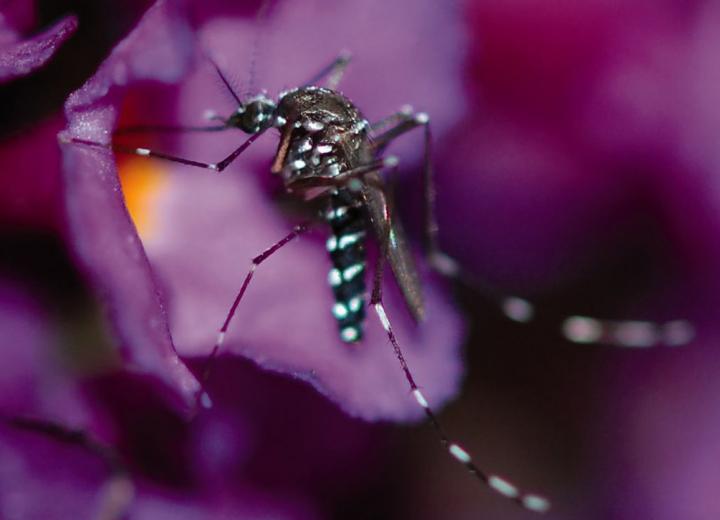Mosquitoes more likely to lay eggs in water sources near flowers

This is an Asian tiger mosquito (Aedes albopictus) feeding on the nectar of a flowering butterfly bush (Buddleja davidii). Credit: Entomological Society of America
Researchers from the USDA and the University of Florida studied the Asian tiger mosquito (Aedes albopictus) and its egg-laying preferences. This mosquito is known to transmit yellow fever, dengue, and chikungunya, and it has been spreading throughout the United States.
Asian tiger mosquitoes prefer to lay eggs in containers, so the first thing the scientists decided to test was whether the size of the containers made any difference. They were also curious about whether or not the presence of flowers might affect the egg-laying behavior, due to the fact that mosquitoes drink nectar from flowers.
The researchers studied female mosquitoes that had been fed bloodmeals and released in large cages with water containers flowering buttterfly bushes (Buddleja davidii).
They found significantly more eggs in the largest containers, and they found more eggs in containers next to flowering bushes than in containers without flowers.
These findings could lead to new methods of controlling the mosquito.
“One of the potential outcomes of this study might be that someone could look at the flower fragrances as a way to lure egg-laying female mosquitoes to some sort of trap,” said Dr. Phil Kaufman, one of the researchers.
“This study provides evidence of the attractiveness of flowering butterfly bushes to ovipositing (i.e., egg-laying) Aedes albopictus,” said Dr. Timothy Davis, another author. “Ovipositing mosquitoes are those that have taken a bloodmeal and, in instances where pathogen transmission is occurring, are the potential vectors as they may have acquired the pathogen through the bloodmeal. Therefore, exploiting the attractiveness of flowering butterfly bushes in developing control techniques could assist in stopping pathogen transmission.”
The researchers suggest that female mosquitoes lay eggs near flowers for a variety of possible reasons. Nectar is an important energy source, so pregnant females are obviously attracted to the flowers in order to feed themselves. But it could also have something to do with providing food for the next generation in the form of nectar.
“Putting eggs in water near a nectar source may be a way of provisioning for the offspring, which do need sugar upon emergence,” said Dr. Kaufman.
The findings of this study may be used one day to increase the effectiveness of mosquito trapping and monitoring efforts, especially if the attractants from flowers can be isolated and replicated.
“Incorporation of phytochemicals that are produced by butterfly bush may enhance ovitrap effectiveness, thereby improving surveillance and control efforts,” according to the authors.
###
The full article, “Aedes albopictus (Diptera: Culicidae) Oviposition Preference as Influenced by Container Size and Buddleja davidii Plants,” is available at http://jme.
The Journal of Medical Entomology is published by the Entomological Society of America, the largest organization in the world serving the professional and scientific needs of entomologists and people in related disciplines. Founded in 1889, ESA today has nearly 7,000 members affiliated with educational institutions, health agencies, private industry, and government. Members are researchers, teachers, extension service personnel, administrators, marketing representatives, research technicians, consultants, students, and hobbyists. For more information, visit http://www.
Media Contact
All latest news from the category: Health and Medicine
This subject area encompasses research and studies in the field of human medicine.
Among the wide-ranging list of topics covered here are anesthesiology, anatomy, surgery, human genetics, hygiene and environmental medicine, internal medicine, neurology, pharmacology, physiology, urology and dental medicine.
Newest articles

Superradiant atoms could push the boundaries of how precisely time can be measured
Superradiant atoms can help us measure time more precisely than ever. In a new study, researchers from the University of Copenhagen present a new method for measuring the time interval,…

Ion thermoelectric conversion devices for near room temperature
The electrode sheet of the thermoelectric device consists of ionic hydrogel, which is sandwiched between the electrodes to form, and the Prussian blue on the electrode undergoes a redox reaction…

Zap Energy achieves 37-million-degree temperatures in a compact device
New publication reports record electron temperatures for a small-scale, sheared-flow-stabilized Z-pinch fusion device. In the nine decades since humans first produced fusion reactions, only a few fusion technologies have demonstrated…





















